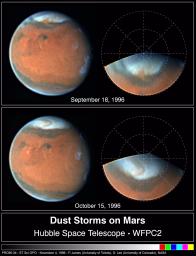
|
Springtime Dust Storm Swirls at Martian North Pole
- Click the image above for a larger view
- Full-Res JPEG (2061 x 2701) (317.1 kB)
- Full-Res TIFF (2061 x 2701) (7.0 MB)
Caption:
Two Hubble Space Telescope images of Mars, taken about a month apart on September 18 and October 15, 1996, reveal a state-sized dust storm churning near the edge of the Martian north polar cap. The polar storm is probably a consequence of large temperature differences between the polar ice and the dark regions to the south, which are heated by the springtime sun. The increased sunlight also causes the dry ice in the polar cap to sublime and shrink.
Mars is famous for large, planet-wide dust storms. Smaller storms resembling the one seen here were observed in other regions by Viking orbiters in the late 1970s. However, this is the first time that such an event has been caught near the receding north polar cap. The Hubble images provide valuable new insights into the behavior of localized dust storms on Mars, which are typically below the resolution of ground-based telescopes. This kind of advanced planetary "weather report" will be invaluable for aiding preparation for the landing of NASA's Pathfinder spacecraft in July 1997 and the arrival of Mars Global Surveyor orbiter in September 1997.
Top (September 18, 1996) - The salmon colored notch in the white north polar cap is a 600-mile (1,000 kilometer) long storm -- nearly the width of Texas. The bright dust can also be seen over the dark surface surrounding the cap, where it is caught up in the Martian jet stream and blown easterly. The white clouds at lower latitudes are mostly associated with major Martian volcanos such as Olympus Mons. This image was taken when Mars was more than 186 million miles (300 million kilometers) from Earth, and the planet was smaller in angular size than Jupiter's Great Red Spot!
Bottom (October 15, 1996) - Though the storm has dissipated by October, a distinctive dust-colored comma-shaped feature can be seen curving across the ice cap. The shape is similar to cold fronts on Earth, which are associated with low pressure systems. Nothing quite like this feature has been seen previously either in ground-based or spacecraft observation. The snow line marking the edge of the cap receded northward by approximately 120 miles (200 kilometers), while the distance to the Red Planet narrowed to 170 million miles (275 million kilometers).
Technical notes: To help compare locations and sizes of features, map projections (right of each disk) are centered on the geographic north pole. Maps are oriented with 0 degrees longitude at the top and show meridians every 45 degrees of longitude (longitude increases clockwise); latitude circles are also shown for 40, 60, and 80 degrees north latitude. The color images were assembled from separate exposures taken with the Wide Field Planetary Camera 2.
Background Info:
This image and other images and data received from the Hubble Space Telescope are posted on the World Wide Web on the Space Telescope Science Institute home page at URL http://oposite.stsci.edu/ .
Cataloging Keywords:
| Name | Value | Additional Values |
|---|---|---|
| Target | Mars | |
| System | Jupiter | |
| Target Type | Planet | |
| Mission | Hubble Space Telescope (HST) | Mars Global Surveyor (MGS), Viking |
| Instrument Host | Hubble Space Telescope | Mars Global Surveyor |
| Host Type | Space Telescope | Orbiter |
| Instrument | Wide Field/Planetary Camera 2 (WFPC2) | |
| Detector | ||
| Extra Keywords | Atmosphere, Color, Dust, Infrared, Map, Mountain, Storm, Visual, Volcano | |
| Acquisition Date | ||
| Release Date | 1998-05-02 | |
| Date in Caption | 1996-09-18 | 1996-10-15 |
| Image Credit | JPL/NASA/STScI | |
| Source | photojournal.jpl.nasa.gov/catalog/PIA01251 | |
| Identifier | PIA01251 | |
